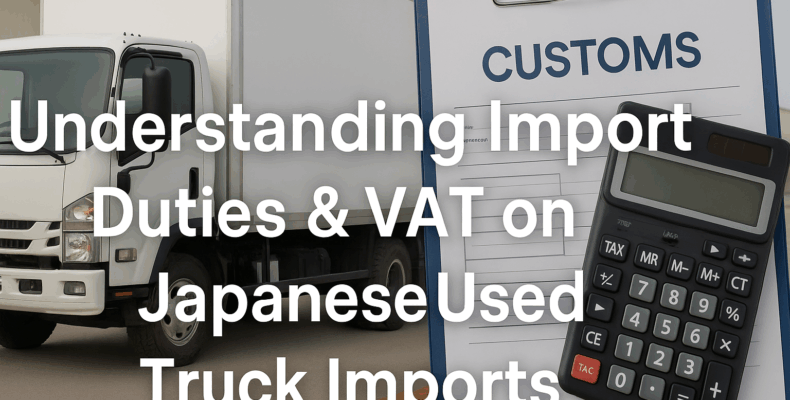Importing a Japanese used truck can be a smart investment. However, to avoid surprises, you must understand import duties, Value Added Tax (VAT), and other local charges that apply when the vehicle enters your country. These costs can significantly affect your total price, so knowing how they work is essential.
In this article, we’ll walk you through the key concepts, explain how fees are calculated, and offer tips to save money on your truck import.
🚛 Why You Should Understand Import Duties and VAT
Import duties and VAT are government-imposed taxes. They protect domestic markets and generate revenue. When importing a Japanese truck—such as an Isuzu Elf, Hino Dutro, or Mitsubishi Fuso Canter—you’ll likely face both types of charges.
Not preparing for these costs could delay customs clearance, increase total expenses, or even lead to penalties.
📦 What Is an Import Duty?
Import duty is a tax placed on goods brought into a country from abroad. The amount varies by country and depends on several factors:
-
Vehicle age
-
Engine size
-
Emission standard
-
Vehicle classification (commercial, agricultural, etc.)
-
CIF value (Cost + Insurance + Freight)
For example:
-
Kenya may apply up to 25% import duty on used trucks
-
Tanzania uses a standard formula based on truck type
-
Philippines requires computation via BOC-assessed values
The CIF value is usually the basis for duty calculation, so always ensure your invoice is accurate.
💰 What Is VAT (Value Added Tax)?
VAT is a consumption tax added to goods and services at the point of import or sale. It’s applied after import duty is calculated. In many countries, VAT ranges between 12% and 20%.
Here’s how the cost builds:
-
Calculate CIF value
-
Apply import duty
-
Add duty to CIF, then apply VAT
For example, if your CIF value is $10,000 and import duty is 25%, the taxable base for VAT becomes $12,500. If VAT is 16%, you’ll pay $2,000 in VAT.
🌍 Examples by Region
✅ Africa
-
Uganda: VAT is 18%, import duty is around 25%
-
Ghana: Includes multiple taxes—import duty, NHIL, VAT, ECOWAS levy
-
Zambia: Offers duty relief on trucks for agriculture/logistics
✅ Caribbean
-
Jamaica: VAT (called GCT) is 15%; additional fees apply
-
Trinidad & Tobago: VAT is 12.5%, with motor vehicle tax on top
✅ Southeast Asia
-
Philippines: VAT is 12%, but additional customs duties vary
-
Bangladesh: Complex system of duty, VAT, and advance tax (AT)
🧾 How to Calculate Total Import Costs
To estimate what you’ll pay, follow this method:
Total Import Cost = CIF + Import Duty + VAT + Local Fees
Also factor in:
-
Port handling
-
Agent or broker fees
-
Pre-delivery inspections
-
Roadworthy test (if required)
Some countries allow deferred VAT payments or input VAT claims for registered businesses, so be sure to ask your local tax advisor.
📋 Tips to Save on Duties and VAT
-
Choose the right truck classification (commercial vs personal)
-
Use licensed customs brokers to avoid mistakes
-
Buy from reputable exporters with complete paperwork
-
Consider newer trucks with cleaner emissions for lower duty
-
Register under a business name for tax reclaim eligibility
👉 To make the process easier, use one of these:
Top 5 Trusted Japanese Used Truck Exporters for Global Buyers
They’ll guide you through the full import process with accurate documentation.
📝 Final Thoughts
Understanding import duties and VAT helps you avoid surprises and stay within budget. It also ensures your truck clears customs smoothly and legally.
By learning how taxes work in your country, working with trusted exporters, and preparing early, you’ll make importing your Japanese used truck easier—and more profitable.
